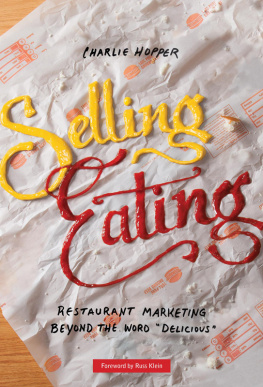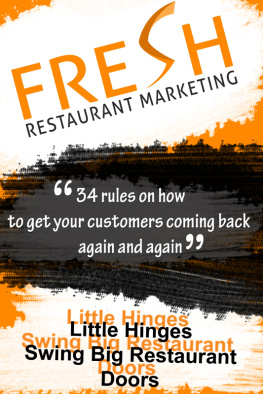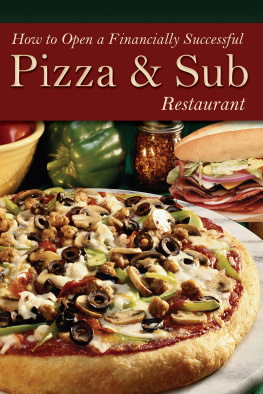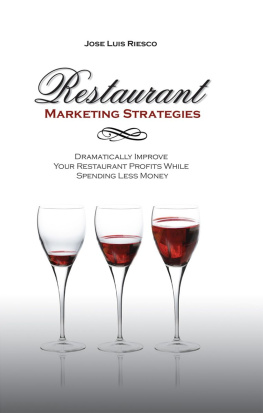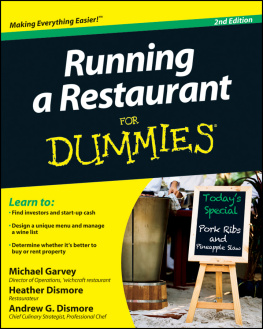Selling Eating
Restaurant Marketing Beyond The Word Delicious
Charlie Hopper

Published by Young & Laramore, Inc.
Young & Laramore, Inc.
407 Fulton Street, Indianapolis, IN 46202
www.yandl.com
Copyright 2013 by Young & Laramore, Inc.
Portions of this book originally appeared in Food & Drink International, QSRweb, Adweek, and on SellingEating.com.
Cover and book design by Zac Neulieb of Young & Laramore.
Cover photography by Harold Lee Miller.
All rights reserved. No part of this book may be reproduced in any form or by any electronic or mechanical means, including information storage and retrieval systems, without permission in writing from the publisher, except by a reviewer who may quote brief passages in a review.
ISBN: 978-0-9898619-2-2 (eBook)
ISBN: 978-0-9898619-0-8 (paperback)
ISBN: 978-0-9898619-1-5 (hardcover)
Dedicated to Marj, Molly, Ted and Will,
whom I like going out to eat with
Foreword
In most restaurant organizations, theres a culture in place thats working against fresh, attention-getting marketing that maximizes both sales and profitabilityand also builds the brand. In fact, people get criticized for talking about the long-term value of the brand, as if its frivolous to bring it up, despite the fact the financial community places tremendous value on brands. Too many managers in the industry, in most industries for that matter, are playing to not lose. They will get what they expect. If you are playing to win fantastically, read on.
A restaurants brand is especially important when its time for the investors to get their money out. Its too late by then, of course.
Its a tree you should have planted twenty years ago.
So plant the tree now. Selling Eating is a good place to start.
The whole time I was reading Selling Eating, I almost felt like Hopper had been a voyeur, watching what Ive encountered in my career over all these years. His deductions about what we were trying to do with Burger King are on target, and as I read I felt a lot of empathy. Selling Eating shows a breadth and a certain comprehensiveness that I think is the right way to think about what the possibilities are for any given brand.
Overall, the quality of the observations and insights are excellent, and I see a good dose of originality in the bookHopper has found some really fresh ways to chronicle his points of view. Its the kind of book that you want to read and re-read, and kind of build out with additional perspectives of your own as you go through it.
The rest is up to you. With this newfound insight in hand, do you have the vision, thought and service leadership, and managerial courage to transform an entire culture from the way weve always done it to a culture of originality, excellence and outperformance?
Russ Klein
Former Global President and CMO for Burger King Corporation. During Kleins tenure the brand registered a record six straight years of worldwide same store sales growth and was recognized by Adweek as Advertiser of the Decade for the 2000s.
Acknowledgements
For years Ive worked with people who have been actively finding new ways to sell all kinds of stuffincluding but not limited to eatingand Id like to thank my colleagues Paul Knapp, Tom Denari, Carolyn Hadlock, and (for essentially willing this project into being) Bryan Judkins, each for their encouragement and support as I focus on the specifics of Selling Eating.
Together weve sold a lot of good meals.
Id also like to thank Adam Hoover for keeping this project on track, and David Young and Jeff Laramore, who founded the agency where Ive spent many hours in many conference rooms, sitting (or pacing, or lying on the floor beneath the conference table) with the two of them, Tom Denari, and many others directly involved with conceiving and executing the hard work of marketing a restaurantfor demanding I rise to their level of intellectual honesty, devotion to nuance, drive to uncover insights, and basic Midwestern work ethic. There have been dozens if not hundreds of people Ive worked with and for, in many places, who have influenced me over a couple of decades. Many of them are mentioned in this book. Many, of course, are not. But theyre still a part of the project.
As I think about all the different opinions, and all the different choices we made, I chucklingly conclude: nobody can agree completely on what makes customers trade money for food.
Not the professionals with their PowerPoint decks and marketing MBAs and Effie Awards and years of experience.
Not the directors who specialize in super close-up, slowly rotating shots of perfectly groomed food mounded meticulously or mysteriously flying through the air.
Not celebrity chef David Chang. Not David C. Novak, current CEO of Yum! (their exclamation, not mine). Not food critic for The New York Times Pete Wells nor his nemesis, food showman Guy Fieri, nor the random batches of regular folks convened in focus group rooms across America.
Not the thirty-year-old who inherited her parents successful restaurant and is scared to try anything different for fear it might break the spell. Not the stressed-out franchise owner wondering which of the customers out there in his dining room just gave dinner one star on Yelp.
Nobody knows.
Thats beautiful, isnt it?
No one can say for certain what induces a human being to choose one meal over another.
Restaurant marketers everywhere are constantly showing up at work, parking, coming in, putting down their things, and asking themselves: what now? What should we do? What will work today? What opportunities are we missing?
Everyone is trying to answer those questions as best they can.
Including, nowwith this book, and after working alongside lots of smart peopleme.
Preface
Grocery stores sell food.
Restaurants sell eating.
Restaurants sell immediate gratificationno planning required. Restaurants sell indulgenceof yourself, of your family. Restaurants sell all five senses at once, in a place where The Grasshopper in the Aesop fable can go after fiddling all day to hang out with friends and laugh and eat.
Grocery stores are where The Little Red Hen goes to buy baking supplies before scolding everyone she knows for not helping.
When it comes to marketing, it seems like The Grasshopper gives us a lot more to work with.
Eating is the bright spot in a persons day. An oasis. A break.
Eating is fun.
So I ask: why is insightful, persuasive communication often missing from restaurant marketing? Why do restaurants rely on tired ideas more than any other major advertiser? Why doesnt it seem like fun most of the time?
Must every menu iteminto which (presumably) a great deal of thought, expense, labor and imagination has been sunkbe reduced to the adjective delicious?
Must every shrimp be succulent? I think not.
For most of my career Ive sold eating, and spent a lot of the hours when I wasnt asleep (and some of the sleeping hours, too, actually) thinking about ways to persuade people to show up hungry in large numbers.
Maybe I can help get you past the clichs and tactical approaches developed by people dead before most of us were born.
This book is probably best viewed as a play book. Im starting out with some basic marketing thoughts, without which any kind of success when handling a brand is random, undisciplined, lacking in aspiration, and repeatable only through luck.
Next, because Ive observed almost every day of my professional life how a good marketing idea either flies or fails in its presentation to the public, the second part of the book contains my beliefs about communication.
Next page
